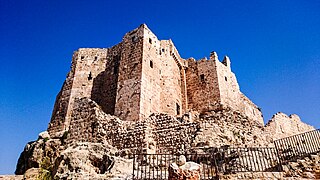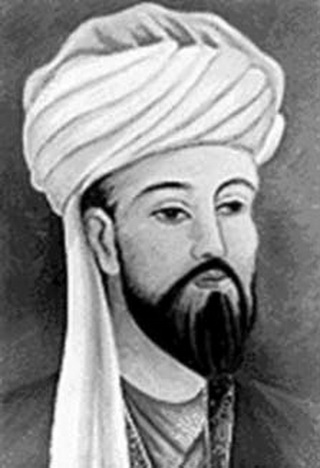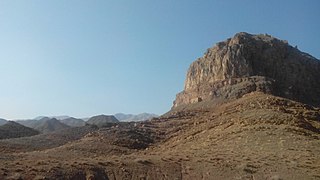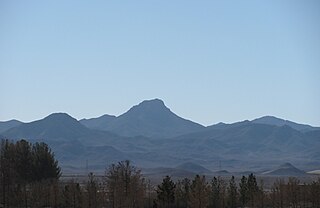Related Research Articles

The Order of Assassins or simply the Assassins were a Nizari Isma'ili order that existed between 1090 and 1275 AD, founded by Hasan-i Sabbah.

Alamut is a mountain fortress at an altitude of 2163 meters at the central Alborz, in the Iranian stanza of Qazvin, about 100 kilometers from Tehran. In 1090 AD, the Alamut Castle, a mountain fortress in present-day Iran, came into the possession of Hassan-i Sabbah, a champion of the Nizari Ismaili cause. Until 1256, Alamut functioned as the headquarters of the Nizari Ismaili state, which included a series of strategic strongholds scattered throughout Persia and Syria, with each stronghold being surrounded by swathes of hostile territory.

Hasan-i Sabbah, also known as Hasan I of Alamut, was a religious and military leader, founder of the Nizari Ismai'li sect widely known as the Hashshashin or the Order of Assassins, as well as the Nizari Ismaili state, ruling from 1090 to 1124 AD.

Abu Ja'far al-Mansur ibn al-Faḍl al-Mustarshid bi'llah usually known by his regnal name Al-Rashid bi'llah was the Abbasid caliph in Baghdad from 1135 to 1136. He succeeded his father al-Mustarshid in the year 1135. He ruled for just one year from 1135 up to his deposition on 17 August 1136 when the populace of Baghdad rose in revolt against him.

Rashid al-Din Sinan also known as the Old Man of the Mountain, was an Arab Muslim missionary who served as the leader of the Nizari Ismaili state and the Order of Assassins from 1162 until his death in 1193. An adherent of Nizari Ismailism, a branch of Shia Islam, he was a prominent figure during the Crusades.
Jalāl al-Dīn Ḥasan III (1187–1221), son of Nūr al-Dīn Muḥammad II, was the 25th Nizari Isma'ili Imām. He ruled from 1210 to 1221.

Gerdkuh was a castle of the Nizari Isma'ili state located near Damghan in the region of Qumis.
Kiyā Buzurg-Ummīd was a dāʿī and the second ruler (da'i) of the Nizari Isma'ili State, ruling Alamut Castle from 1124 to 1138 CE. He was of Daylami origin from the region of Rudbar.

The Nizari state was a Nizari Isma'ili Shia state founded by Hassan-i Sabbah after he took control of the Alamut Castle in 1090 AD, which marked the beginning of an era of Ismailism known as the "Alamut period". Their people were also known as the Assassins or Hashashins.
Nūr al-Dīn Muḥammad II or ʾAʿlā Muḥammad was the Nizari Isma'ili Imām of Alamūt who reigned the longest period out of any lord (Khudawand) of Alamut, forty-four years. He affirmed the policies of his father, Hassan Ala Dhikrihi's Salam, who had been stabbed to death a year after proclaiming Qiyāma, or Resurrection.

ʿAlāʾ ad-Dīn Muḥammad III, more commonly known as ʿAlāʾ ad-Dīn (علاءالدین), son of Jalāl al-Dīn Ḥasan III, was the 26th Nizāri Isma'ilism Imām. He ruled the Nizari Ismaili state from 1221 to 1255. By some accounts, he was considered a respected scholar and the spiritual and worldly leader of the Nizari Ismailis. The intellectual life of Persia has been described as having flourished during his 34-year reign. Allegedly, he was known for his tolerance and pluralism. His reign witnessed the beginnings of the Mongol conquests of Persia and the eastern Muslim world. He was assassinated by an unknown perpetrator on 1 December 1255, and was succeeded by his eldest son, Rukn al-Din Khurshah, in 1255.
Shams al-Din Muhammad was the 28th imam of the Nizari Isma'ili community. Little is known about his life. He was the first imam to rule after the destruction of the Nizari state by the Mongol Empire, and spent his life hiding his true identity.
By the late 11th century, the Shi'a sub-sect of Ismailism had found many adherents in Persia, although the region was occupied by the Sunni Seljuk Empire. The hostile tendencies of the Abbasid–Seljuk order triggered a revolt by Ismailis in Persia under Hassan-i Sabbah.
The Mongol campaign against the Nizaris of the Alamut period began in 1253 after the Mongol invasion of the Khwarazmian Empire and a series of Nizari–Mongol conflicts. The campaign was ordered by the Great Khan Möngke and was led by his brother, Hülegü. The campaign against the Nizaris and later the Abbasid Caliphate was intended to establish a new khanate in the region—the Ilkhanate.

Ghal'eh Kuh of Ferdows is a ruined fortress on top of Kuh-e Ghal'eh, located south of Ferdows (Tun) in South Khorasan Province, Iran. The fortress was famously used by the Nizari Ismailis of the Alamut period, and was the biggest Nizari stronghold in the Quhistan region, according to the Tarikh-i Jahangushay.
Qal'eh Dokhtar, Ferdows, also the Ghal'eh Kuh of Hasanabad, is a small ruined fortress located north west of Ferdows (Tun) and near the village Hasanabad in South Khorasan Province, Iran. The fortress was used by the Nizari Ismailis of the Alamut period.
The siege of Maymun-Diz, an unlocated fortress and the stronghold of the leader of the Nizari Ismaili state, Imam Rukn al-Din Khurshah, occurred in 1256, during the Mongol campaign against the Nizaris led by Hülegü.
References
- 1 2 B. Hourcade, “ALAMŪT,” Encyclopædia Iranica, I/8, pp. 797-801; an updated version is available online at http://www.iranicaonline.org/articles/alamut-valley-alborz-northeast-of-qazvin- (accessed on 17 May 2014).
- ↑ Kassam, Tazim R. (1995). Songs of Wisdom and Circles of Dance: Hymns of the Satpanth Isma'ili Muslim Saint, Pir Shams. SUNY Press. p. 120. ISBN 978-0-7914-2591-6.
- ↑ Daftary, Farhad (2007). The Isma'ilis: Their History and Doctrines. Cambridge University Press. p. 329. ISBN 978-1-139-46578-6.
- ↑ واحددرآبادی, رقیه; برومند, صفورا. "اتهام به الحاد و مصادیق آن در دوران سلجوقیان" (PDF). پژوهش نامه تاریخ اجتماعی و اقتصادی (in Persian). 4 (1): 83–102. ISSN 2383-1278.
- ↑ Peacock, A. C. S. (2015). Great Seljuk Empire. Edinburgh University Press. p. 75. ISBN 978-0-7486-9807-3.
- 1 2 Wasserman, James (2001). The Templars and the Assassins: The Militia of Heaven. Simon and Schuster. p. 91. ISBN 978-1-59477-873-5.
- ↑ Daftary, Farhad (2007). The Isma'ilis: Their History and Doctrines. Cambridge University Press. pp. 334–335. ISBN 978-1-139-46578-6.
- ↑ Wasserman, James (2001). The Templars and the Assassins: The Militia of Heaven. Simon and Schuster. p. 101. ISBN 978-1-59477-873-5.
- ↑ Mirza, Nasseh Ahmad (1997). Syrian Ismailism: The Ever Living Line of the Imamate, AD 1100-1260. Psychology Press. p. 12. ISBN 978-0-7007-0505-4.
- ↑ Lewis, Bernard (2011). The Assassins: A Radical Sect in Islam. Orion. pp. 54–. ISBN 978-0-297-86333-5.
- ↑ Wasserman, James (2001). The Templars and the Assassins: The Militia of Heaven. Simon and Schuster. p. 102. ISBN 978-1-59477-873-5.
- ↑ Daftary, Farhad (1992). The Isma'ilis: Their History and Doctrines. Cambridge University Press. p. 423. ISBN 978-0-521-42974-0.
- ↑ Daftary, Farhad. "The Mediaeval Ismailis of the Iranian Lands | The Institute of Ismaili Studies". www.iis.ac.uk. Archived from the original on 3 August 2016. Retrieved 31 March 2020.
- ↑ Willey, Peter (2005). Eagle's Nest: Ismaili Castles in Iran and Syria. Bloomsbury Academic. pp. 75–85. ISBN 978-1-85043-464-1.
- ↑ Willey, Peter. Eagle's Nest - Ismaili Castles in Iran and Syria (New York: I. B. Tauris, 2005), 83
- ↑ Juvaini, Ata-Malik; Qazvini, Mirza Muhammad (1997). Genghis Khan: The History of the World Conqueror. Manchester University Press. p. 609, note 9. ISBN 978-0-7190-5145-6.
- ↑ Ohsson, Constantin Mouradgea d' (1834). Histoire des Mongols (in French). p. 201.
- ↑ The Chinese Recorder and Missionary Journal. American Presbyterian Mission Press. p. 310, note 4.
- 1 2 3 Daftary, Farhad (1992). The Isma'ilis: Their History and Doctrines. Cambridge University Press. p. 429. ISBN 978-0-521-42974-0.
- 1 2 3 4 5 Virani, Shafique N. (2003). "The Eagle Returns: Evidence of Continued Isma?ili Activity at Alamut and in the South Caspian Region Following the Mongol Conquests". Journal of the American Oriental Society. 123 (2): 351–370. doi:10.2307/3217688. ISSN 0003-0279. JSTOR 3217688.
- ↑ Boyle, John Andrew (1977). The Mongol World Empire, 1206-1370. Variorum Reprints. ISBN 978-0-86078-002-1.